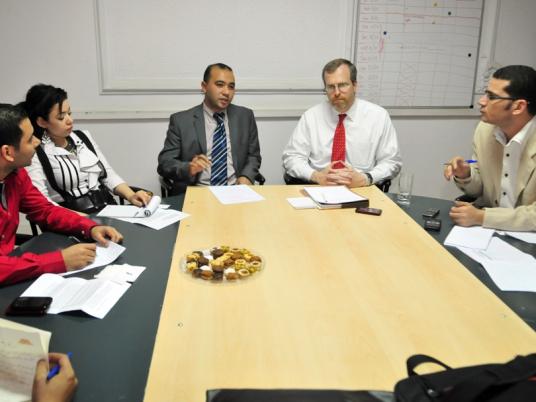Throughout the 18-day Egyptian uprising, the walls of Cairo’s downtown buildings were covered with revolutionary graffiti, while makeshift museums dominated various corners of Tahrir Square. Now, four months later, creativity is finding its way below ground, with a number of exhibitions being formed at the Sadat metro station.
A small-scale photography exhibition documenting the protests and honoring the revolution’s martyrs opened on 12 May, only to be followed a week later by the massive “Liberating Egypt” exhibition. With over 300 paintings and 80 photographs – half of which concern the 25 January revolution – the busy walk-through art show has become a veritable museum.
“Over half a million people use the Sadat metro station every day,” said Islam al-Masry, the exhibition’s organizer. “This, I believe, is the largest possible exposure of artwork worldwide.”
While not the first art exhibition in a Cairo metro station (a few were previously held at the Opera station) “Liberating Egypt” is certainly the largest.
“Our main idea was to expose the public to art,” Masry added, describing the exhibition as an artistic renaissance.
The idea first came up after Mubarak stepped down on 12 February, although it was envisioned as an open-air exhibit at Tahrir Square where thousands of people convened every Friday. Yet, due to technical and financial constraints, the plans were moved below ground.
“The Sadat metro station is technically at Tahrir Square, and it does function like a museum anyway, offering massive exhibition space,” Masry explained.
The metro station’s management welcomed the idea and approval was obtained within 24 hours.
Holding such an exhibition in the past would have been practically impossible, as much of the work is political and would thus have required security clearance from the State Security Investigative Service.
Many works show caricatures of Hosni Mubarak, and other present symbols of liberation. “Liberating Egypt does an excellent job of documenting the revolution,” said Awatef Hamdy, a schoolteacher in her forties.
Some pieces, however, don’t deal directly with the revolution and were, in fact, produced before 25 January.
In addition to curating the exhibition, Masry is exhibiting his “Freedom Flotilla” piece. Comprised of 50,000 leaves collected by the artist over three years, the works depicts a monstrous creature attacking the international flotilla that attempted to break the Gaza blockade in May 2010.
“The work shows the injustice of the Israeli state,” the artist told al-Masry al-Youm, adding that he plans to donate proceeds from the exhibition to the second freedom flotilla, as well as to those injured in the Arab revolutions.
Other works are not political, at least not explicitly.
“I didn’t want to exhibit revolution-related works,” said Yuri Fareed, a photographer participating in the show. “I believe it will take years before the revolution bears fruit and real change happens. That’s why I exhibited earlier works.”
For Fareed, as well as for other participating artists, the most important thing is to break away from the exclusivity of gallery spaces.
“There’s a common perception that art is a luxury for the rich and it’s hard to change people’s minds on that issue through mere discussion. Yet by showing the works in such a public space, people are forced to engage with them in some way, even if it’s just by mocking the works at first,” Fareed told al-Masry al-Youm.
“I come here regularly and people often ask me what the artworks ‘mean.’ I respond with the same question, adding that they might get a different idea, and to me that’s a good start.”
Hamdy agrees. “People are bound to engage with the works on display in one way or another. By nature, humans are curious creatures,” she said.
Eleven-year-old Hassan, who sells tissue paper at Sadat station, has been curious to meet the artists. Working at the station for seven years, this has been one of the most exciting experiences of his life, he told Al-Masry Al-Youm, adding that he would love to see the artists working on their pieces for the next exhibition.
It seems that Hassan's wish may be granted. As Masry explains, two corridors at the station are to be permanently allocated for art exhibitions. While Masry has already begun selecting works for the next exhibition, he is most excited about the grand exhibition that he has in mind for the revolution’s first anniversary in January 2012.
"This exhibition will take up the whole of Sadat metro station,” he said.
Liberating Egypt will be exhibited at the Sadat metro station until 22 June


